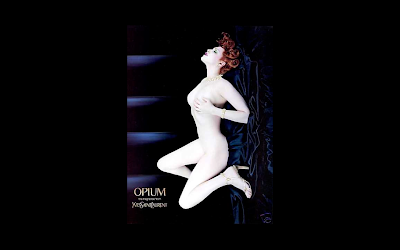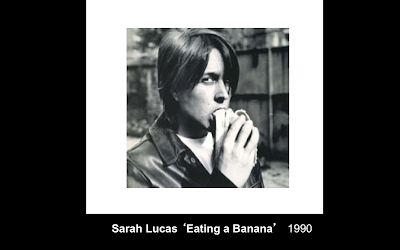The lecture introduces theories of The Gaze, through the writings of John Berger, Laura Mulvey, Rosalind Coward and Professor Griselda Pollock. It proposes that The Male Gaze identified by Mulvey through film, and Berger through painting, is in fact synonymous with The Gaze of The Media in contemporary western culture.
The lecture provides readings which follow the message of the key texts and encourages the questioning of our contemporary privileging of the visual in the western construction of desire.
It also looks at the impact this has in the everyday, and how the prevalence of the male Gaze normalizes these perceptions of women and their bodies and is internalized by women themselves. This is a complex area of investigation, and rather than a simple ‘reversal’ of the Gaze onto the male body, the lecture seeks to address and question image makers as to the possibility of an alternative portrayal of the body.
‘according
to usage and conventions which are at last being questioned but have by no
means been overcome - men act and women appear. Men look at women. Women watch
themselves being looked at’
(Berger 1972) - Most misunderstood quote. This does not mean woman are vein, its difficult for women to not think of themselves been looked at. Constant comparison everyday, men are not subjected to this. Women constantly survey the femininity.
He looks at European paintings to see the pattern of women being used. The body is fully on display. The angle of the mirror is incorrectly rendered giving a double view. The view we see and what she sees. The mirror is a device to justify the act of looking, so others can enjoy the female body.
Excuse for a pleasure in looking. - Distracting device.
Excuse for a pleasure in looking. - Distracting device.
Same concept in contemporary advertising. Draw to crotch, legs open, this is ok
because she is pre occupied with her self....this makes it ok for the audience to look at her.
because she is pre occupied with her self....this makes it ok for the audience to look at her.
Repeated pose in advertising. Mytholoical representation the the woman.
More sentimental virginal picture. She covers her face with her hand advertising technique.
Concentration of focus on the body rather than her as a person. This
allows the viewer to look at the painting without judgement
More sentimental virginal picture. She covers her face with her hand advertising technique.
Concentration of focus on the body rather than her as a person. This
allows the viewer to look at the painting without judgement
3/4 picture plain again. More sexual with legs parted and cupping the breast.
This advert was deemed too sexual for public viewing in magazines and bill boards.
To get round this they flipped the image round to give more focus to the face.
Takes emphasis off the position.
This advert was deemed too sexual for public viewing in magazines and bill boards.
To get round this they flipped the image round to give more focus to the face.
Takes emphasis off the position.
Traditional Nude oil painting. The woman has her head turned and eyes up.
She has knowledge of the viewers presence. Passive nude. Quite casual
She has knowledge of the viewers presence. Passive nude. Quite casual
300 years later still very similar. The hand in this is quite deliberate, quite defensive.
Berger thinks she's more of a prostitute - flower in the hair, exquisite cloth.
Berger thinks she's more of a prostitute - flower in the hair, exquisite cloth.
Artists use the nudes to challenge the traditions of the women beeing looked
at as an object of lust and desire.
at as an object of lust and desire.
banned from public view, sexual connotations in the hand.
Mirroring of the gaze - Woman at bar ready to serve us. Reflection is incorrect
this allows us to see her from 2 viewing positions at once. See her as ourselves
and as the character on the right. We see from his point of view.
this allows us to see her from 2 viewing positions at once. See her as ourselves
and as the character on the right. We see from his point of view.
Reflection of the photographers studio and the gaze from the woman.
This doubling is reflected in the composition. You are reminded that this a staged
shot. RETURN OF THE GAZE
This doubling is reflected in the composition. You are reminded that this a staged
shot. RETURN OF THE GAZE
She's standing unaware and unnoticed in public. Everybody carries
on their day to day lives. Trying to normalise nudity making it seemingly
un noticed. Berger is saying woman know unconsciously they are being looked at
The use of sunglasses means the woman can't look back. As it looks like she cant
see us looking.
on their day to day lives. Trying to normalise nudity making it seemingly
un noticed. Berger is saying woman know unconsciously they are being looked at
The use of sunglasses means the woman can't look back. As it looks like she cant
see us looking.
Normalization of nudity on the street. The 'Hello Boys' tag line makes it light hearted
and takes some of the tension away from looking at her.
and takes some of the tension away from looking at her.
Film of a man who spys on women, his voyeurism leads him to murdering woman
from the cameras point of view.
from the cameras point of view.
Portrayed in an active manor rather than passive. All the guys are looking back
and happy for them to look. Dont get this challenge in female adverts.
and happy for them to look. Dont get this challenge in female adverts.
Humorous reference to her theory. Uses Freuds theory to look at cinematic spectatorship
Looking at the way the camera breaks the female body down into pieces, looking
at its key components, legs, torso, face, etc
Looking at others bodys as erotic objects in the cinema. Perfect voyeuristic environment
You can look and no body else can see you looking. The result of this is there is
objectification of the women's body.
at its key components, legs, torso, face, etc
Looking at others bodys as erotic objects in the cinema. Perfect voyeuristic environment
You can look and no body else can see you looking. The result of this is there is
objectification of the women's body.
Active character not passive. Men often lead the story in 50's 60's Hollywood cinema
Women are used as just objects, they don't drive the story usually. Even though
Lara Croft is active and an action character, she is still sexually objectified.
Her features are over sexual and enhanced.
Women are used as just objects, they don't drive the story usually. Even though
Lara Croft is active and an action character, she is still sexually objectified.
Her features are over sexual and enhanced.
Pollock Leeds uni Lecturer - painting by a women which portrays women in an
active and gruesome role. Very physical painting, alternative character. The gaze here
is challenged, Pollocks looking for alternatives in art history.
active and gruesome role. Very physical painting, alternative character. The gaze here
is challenged, Pollocks looking for alternatives in art history.
Work wasn't made with theories of the gave in mind. But still it can be read
in the light of those theories. Reclining turned figure. The images has been flipped
round to make you look more at the face. The mirror is turned away, she's not
looking at herself and we have no reflection making you not quite sure
where to look. The image is quite awkward - staged photography.
in the light of those theories. Reclining turned figure. The images has been flipped
round to make you look more at the face. The mirror is turned away, she's not
looking at herself and we have no reflection making you not quite sure
where to look. The image is quite awkward - staged photography.
She works with image and text collaged to make the imagery. Turned face away
from the male gaze implicates violence with the text....'hits the face'
from the male gaze implicates violence with the text....'hits the face'
Well known for combination of text and found imagery
Sexual connotations. She is picturing the self consciousness of eating a banana
that could be looked at in the wrong way. She is critiquing the idea by acting this out
Very confrontational look.
that could be looked at in the wrong way. She is critiquing the idea by acting this out
Very confrontational look.
Substitiution of parts of the body. Eggs as Breasts. Reference to small
breasts. FRIED EGSS
breasts. FRIED EGSS
Looks like she's stuffing money inside her. Criticizing the people who made money
from the nude. Vulgar to make money from the art.
The
idea that women are natural liars has a long pedigree. The key document in this
centuries-long tradition is the notorious witch-hunter's manual, the Malleus Maleficarum or
The Hammer of Witches, which was commissioned by Pope Innocent VIII. The book
was written by two Dominican monks and published in 1486. It unleashed a flood
of irrational beliefs about women's "dual" nature. "A woman is
beautiful to look upon, contaminating to the touch, and deadly to keep,"
the authors warned. They also claimed that "all witchcraft comes from
carnal lust, which is in women insatiable".
It's
not difficult to see these myths lurking behind Pacelli's
description of Knox: "She was a diabolical, satantic,
demonic she-devil. She was muddy on the outside and dirty on the inside. She
has two souls, the clean one you see before you and the other." The
lawyer's claim that she was motivated by "lust" could have come
straight from the Malleus, which insists that women are more "carnal"
than men.
The media prepare 2 stories to compensate for both outcomes. They got this
wrong and posted the wrong outcome.
wrong and posted the wrong outcome.
- The Daily Mail has emerged as the major fall guy by mistakenly publishing the wrong online version of the Amanda Knox verdict.
- Knox won her appeal, but the paper's website initially carried a story headlined "Guilty: Amanda Knox looks stunned as appeal against murder conviction is rejected.”
- The Mail was not the only British news outlet to make the error. The Sun and Sky News did it too and yes - hands up here - so did The Guardian in its live blog.
- It would appear that a false translation of the judge's summing up caused the problem, leading to papers jumping the gun.
- So why has the Mail suffered the greatest flak? In time-honoured fashion, echoing the hot metal days of Fleet Street, it prepared a story lest the verdict go the other way.
- But it over-egged the pudding by inventing "colour" that purported to reveal Knox's reaction along with the responses of people in the court room.
- It even included quotes from prosecutors that were, self-evidently, totally fake.
- In other words, by publishing its standby story, the Mail exposed itself as guilty of fabrication.
Circulation of images with no author. Powerful imagery thats having
a huge effect on teenage girls / boys
Paparazzi feed the public desire
voyeurism has lost its impact as we a saturated with the experience nowadays
people like being looked at.
Further Reading
John
Berger (1972) Ways
of Seeing, Chapter3
Victor
Burgin (1982) Thinking
Photography
Rosalind
Coward (1984) The
Look
Laura
Mulvey
(1973) Visual Pleasure and Narrative Cinema
Griselda
Pollock (1982) Old
Mistresses



































No comments:
Post a Comment